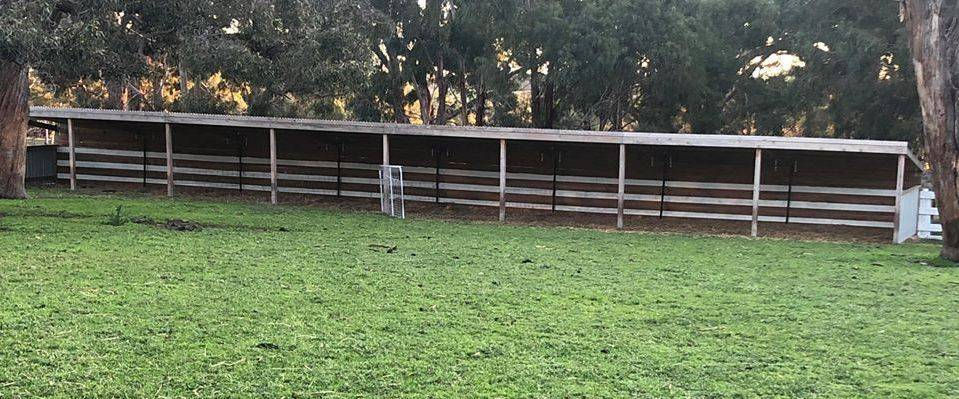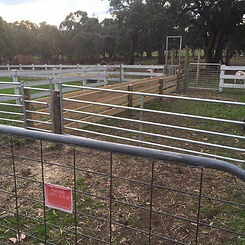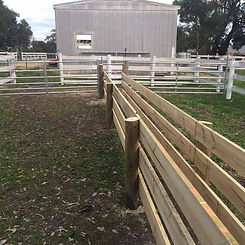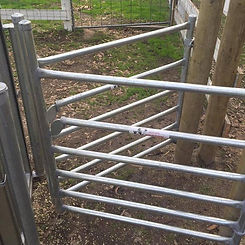
SHEEP CARE
There is a huge amount of information on the Internet regarding the Care of Sheep. For great General Information try Sheep 201 - A Beginner's Guide to Raising Sheep or the book, "Storey's Guide to Raising Sheep", by Paula Simmons and Carol Ekarius.
Every farm is different, every shepherd is different, even different sheep require different approaches to certain areas of care and husbandry. The following is how we run our Farm and the things that work for us. Even these are constantly evolving as we try new approaches, new feeds and new ideas.
Yards and Laneways
A good set of yards is of immense help when working with sheep. We adapted our horse yard for the sheep and it works like a charm. Geoff designed it with a race down the middle leading to a loading ramp, which we haven't used as we usually load them straight into the trailer or float from the entrance gate, but it is there if we need it. The race also has a drafting gate so we can draft the sheep in any of three directions, depending on where we want them to go. Large swinging gates on each side of the yard allow us to easily push the sheep into a smaller area as well as into the race, without having to physically handle them. For a small operation, such as ours, it works perfectly. Our property fencing was also designed with a central laneway in to which six of our paddocks open, again making for ease of movement when transferring the sheep from one paddock to another. Even if you do not require large yards, create a small yard, and get your sheep used to going into it. It will be invaluable if you need to restrain them for husbandry, Vet work or lambing. Feeding them in the yard is a good way to acclimatise them into coming into the yard as they will remember the reward they received and happily go in again. I have added the photos of our yards below.
Shelter
Yes, a barn is fabulous, as are three sided shelters in all paddocks, but these are not always available, so make sure there are always trees in every paddock for shelter from the sun and rain. If possible a shed of some kind needs to be made available in case it is necessary for veterinary purposes. Sheep are fairly hardy, but there is the occasion when one needs to be in a warm, sheltered environment for a short time. This is also handy for any orphan lambs. We have a large machinery shed that we can section off with gates or sheep panels if we need to keep sheep in overnight. We have also built an eight bay shed in our overnight lambing paddock, which allows us to section it off into different sized bays depending on our needs. Each of the bays is designed to be sectioned off with farm gates, so we can have up to eight individual pens or one long pen. A photo is above.
Feeding
There is no fast rule for feeding, as there is no fast rule for how many sheep you can run per hectare. It all depends on how much pasture you have available and how good that pasture is throughout the year.......not just during the Spring Flush but also in mid Winter and mid Summer. If you do not have sufficient feed during the leaner times, it will be quite costly for the purchase of hay and grain. You will also find that sheep, like people metabolise differently, so individuals within a flock may need different amounts of feed. Scales are great but body scoring is always helpful in determining the condition of individual sheep.
A handy guide for body scoring can be found at
https://www.agric.wa.gov.au/management-reproduction/condition-scoring-sheep
Due to our location, and because we run other livestock as well, we find we need to feed out regularly in Winter and Summer. We use a mix of Lucerne Chaff and sheep pellets as well as alternating Lucerne Hay and Grass Hay. Any grain needs to be introduced slowly to ruminants or grain poisoning may occur, causing Bloat, which is often lethal. The higher fibre content grains such as Oats and Sorghum are safer than Wheat and Barley as the fibre slows down the rate of digestion. Lupins are safer still, but must be fed whole or cracked, not ground. If grain or pellets are being fed, 10% - 20% of roughage, such as hay or chaff also needs to be fed. Our sheep have free access to Mineral Blocks and free choice minerals designed for sheep in all paddocks. The best feed for sheep or any ruminants for that matter, is a good variety of grasses, forbs and natural pasture feed. We always know when the new grass is coming through as the hay is no longer acceptable and the sheep wander away to graze instead!!
Health Care Vaccinations
Sheep are vaccinated to protect them against some common serious infectious diseases. Again, some farmers vaccinate, some don't. We are in the category that do. Our sheep receive an annual 5 in 1 injection to protect against the Clostridial diseases.....enterotoxaemia, black leg, black disease, malignant oedema and tetanus. Initially they receive their first shot and a booster four to six weeks later. Pregnant ewes should be vaccinated four to six weeks prior to lambing to ensure their newborn lambs are covered. Our lambs are also injected with Gudair which helps to protect against Johne's Disease. This must be given before the lambs are sixteen weeks of age and their ear tags are marked with a "V" for proof this has been done.
Parasites
Gastro intestinal diseases, caused by internal parasites (worms) are one of the major diseases affecting sheep and lambs, as sheep graze so closely to the ground and their faecal pellets disintegrate allowing the worm larvae access to the ground. Heavy stocking rates and lack of paddock rotation also increase the risk of worm burden. There is a wealth of information about worms and livestock in Australia and our country is at the forefront of research in this area, as we found out when we attended seminars on worms for our llamas. Information about internal parasites can be found at a great Australian site..... www.wormboss.com.au. As worms can become resistant to drenches, and because every farm and season is different, worm (faecal) egg counts can be beneficial, so you are not drenching unnecessarily. More information on these can also be found on www.wormboss.com.au.
Shearing
All of our sheep breeds require annual shearing, which we have done professionally. They are also backlined at the same time to guard against lice.
Hoof Care
Hoof care is an important part of looking after sheep and their hooves/feet should be inspected regularly. Lameness may be caused by overgrown hooves/nails, infection of the foot or possibly infection of the scent gland on the skin above and between the two hooves. For trimming the nails, a good pair of clippers that are comfortable in the hand is necessary. Secateurs can work well or hoof/nail trimmers especially made for the job are available at rural stores. If you are not sure how to clip the nails, there are plenty of teaching videos online, which would be much more helpful than me trying to explain it!
Tail Docking
Sheep have tails for a reason.....to protect the anus, vulva and udder from weather extremes. Tail docking is carried out to minimise fly strike by keeping the rear end of the sheep as clean from urine and faecal matter as possible. The Hair sheep or shedding sheep do not require tail docking. The woolly breeds of sheep may be docked. Some people prefer to leave the tails and this is purely a personal thing. We dock our tails mainly due to the hot summers and problems of fly strike. Flies can strike any area of wool but seem to prefer the moist areas around the tail. Lately we have seen a tendency by some farmers to dock the tail too short. If you are going to dock, it is better to do it early and to leave some tail for protection. This also makes it easier for the shearer as he/she has less chance of catching a ewe's extremely tender points with the blades. The Australian Veterinary Association recommends docking at the third palpable joint from the body, before the age of three months.



